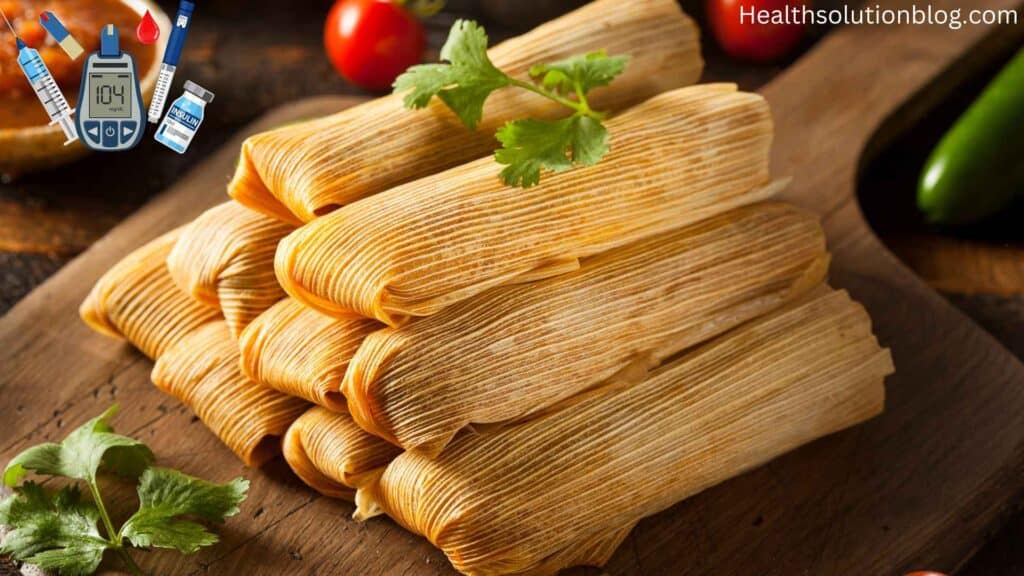
Tamales are a traditional Mexican dish made of corn dough (a dough usually made from corn) and a variety of fillings, such as meat, cheese, vegetables, and fruits. They are typically wrapped in corn husks and steamed. Tamales are a popular food for special occasions, but they can also be enjoyed as an everyday meal.
Diabetes is a chronic disease that affects the body’s ability to process glucose (sugar). People with diabetes need to carefully manage their blood sugar levels to stay healthy.
Tamales are a high-carbohydrate food, which means that they can raise blood sugar levels. However, people with diabetes can still enjoy tamales in moderation. It is important to choose tamales that are made with healthy ingredients and to limit your intake of tamales that are high in saturated fat, cholesterol, and sodium.
Blood sugar levels are an important factor in managing diabetes. When blood sugar levels rise too high, it can damage nerves and blood vessels. This can lead to a variety of health complications, such as heart disease, stroke, and kidney disease.
People with diabetes need to be aware of the impact of different foods on their blood sugar levels. In this article, we will discuss all about tamales and how other ingredients in tamales, such as fat and sodium, can affect blood sugar levels.
Now let’s explain the details of the topic:
Can diabetics eat tamales?
Let’s explore it.
Understanding Tamales
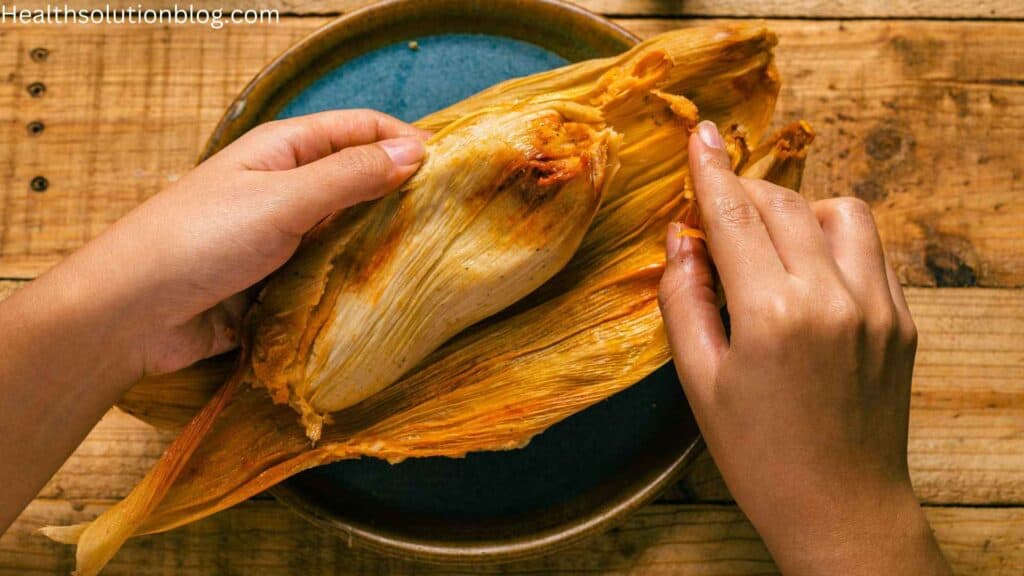
In this section, we will discuss What are tamales, their traditional ingredients, and the Nutritional components of tamales.
What are tamales and their traditional ingredients?

As already discussed, Tamales are a traditional Mexican dish made of corn dough (dough) and a variety of fillings, such as meat, cheese, vegetables, and fruits. They are typically wrapped in corn husks and steamed.
Traditional tamale dough is made from ground corn, water, and lime. The dough is then spread out on a corn husk and filled with the desired filling. The tamale is then wrapped up and steamed.
Common tamale fillings include:
- Meat: chicken, beef, pork, lamb
- Cheese: cheddar, Monterey Jack, cotija
- Vegetables: spinach, onions, peppers, tomatoes
- Fruits: raisins, pineapple, mango
Nutritional components of tamales
Tamales are a high-carbohydrate food, but they also contain a variety of other nutrients, including:
- Calories: A medium-sized tamale contains about 250–300 calories.
- Fat: Tamales contain about 10–15 grams of fat per serving. Most of the fat in tamales is saturated fat, which can raise cholesterol levels.
- Vitamins and minerals: Tamales contain a variety of vitamins and minerals, including vitamin A, vitamin C, calcium, and iron.
- Carbohydrates and fiber: Tamales contain about 30–40 grams of carbohydrates per serving. Most of the carbohydrates in tamales are complex carbohydrates, which provide sustained energy. Tamales also contain a small amount of fiber.
- Protein: Tamales contain about 5–10 grams of protein per serving. The amount of protein in a tamale will vary depending on the filling.
Impact on Blood Sugar Levels

The impact on diabetic blood sugar levels is very important, so in this section, we will discuss the impact of tamales on blood sugar levels.
i. Tamales and their effect on blood sugar
Tamales are a high-carbohydrate food, which means that they can raise blood sugar levels. However, the specific impact of tamales on blood sugar levels will vary depending on the ingredients used and the portion size.
ii. Glycemic index of tamales
The glycemic index (GI) is a measure of how quickly a food raises blood sugar levels. Foods with a high GI are digested quickly and cause a rapid spike in blood sugar levels. Foods with a low GI are digested more slowly and cause a gradual rise in blood sugar levels.
The GI of tamales varies depending on the ingredients used. However, most tamales have a moderate to high GI. This means that they can cause a rapid spike in blood sugar levels, especially in people with diabetes.
iii. Specific ingredients contributing to blood sugar levels
The following ingredients in tamales can contribute to blood sugar levels:
- Carbohydrates: Tamales are made from corn dough, which is a high-carbohydrate food. Carbohydrates are broken down into glucose in the body, which causes blood sugar levels to rise.
- Sugar content: Some tamale recipes include added sugar. Added sugar can also cause blood sugar levels to rise.
- Sodium content: Tamales may also contain high levels of sodium. Sodium can cause the body to retain water, which can lead to increased blood sugar levels.
Addressing Health Concerns

Tamales health concerns are necessary for diabetics to be known. Here, the health concerns about tamales will be discussed.
Risks associated with tamales for diabetics
Following are the risks associated with tamale consumption for diabetics.
1. Blood sugar spikes
Tamales are a high-carbohydrate food, which means that they can cause a rapid spike in blood sugar levels, especially in people with diabetes. This can be dangerous, as it can lead to a variety of health complications, such as heart disease, stroke, and kidney disease.
2. Weight gain and health problems
Tamales are also high in calories and saturated fat. This can lead to weight gain and other health problems, such as high cholesterol and heart disease.
Why may tamales not be suitable for diabetics?
The following reasons tell us why tamales may not be suitable for diabetics:
1. Corn husk and corn-based dough
Tamales are typically made with corn dough and wrapped in corn husks. Corn is a high-carbohydrate food, which means that it can raise blood sugar levels.
2. High carb and sugar content
Tamales are typically filled with meat, cheese, vegetables, and/or fruits. Many of these fillings are high in carbohydrates and sugar, which can further raise blood sugar levels.
Healthier Alternatives and Modifications
If you still want tamales or alternatives, then this section explains all these.
I. Making tamales healthier for diabetics
There are many ways to make tamales healthier for diabetics. Here are a few tips:
- Reduce the sugar and carb content. You can do this by using whole-wheat dough instead of white dough and by limiting the amount of added sugar in the fillings.
- Choose lean protein options. Instead of using fatty meats like pork, opt for leaner proteins like chicken or fish.
- Add vegetables to the fillings. Vegetables are a good source of fiber and nutrients, and they can help slow down the absorption of carbohydrates into the bloodstream.
- Steam or bake your tamales instead of frying them. This will reduce the amount of fat in the tamales.
II. Alternative options for diabetic-friendly Mexican cuisine
If you are looking for alternative options to tamales, there are several other diabetic-friendly Mexican dishes that you can enjoy. Here are a few ideas:
- Grilled fish or chicken tacos
- Chicken or shrimp fajitas
- Black bean soup
- Gazpacho
- Ceviche
But if you like tamales, then the following in this article are a few of the best diabetic-friendly tamale recipes.
III. Tips for managing blood sugar while enjoying tamales
If you are a diabetic who enjoys tamales, there are a few things you can do to manage your blood sugar levels:
- Pair your tamales with a healthy side dish, such as a salad or grilled vegetables. This will help to slow down the absorption of carbohydrates into the bloodstream.
- Avoid eating tamales with sugary drinks, such as soda or juice.
- Monitor your blood sugar levels before and after eating tamales. This will help you to see how tamales affect your blood sugar levels and make adjustments as needed.
It is also important to talk to your doctor about how often and how many tamales you should eat.
Additional tips:
- Eat tamales in moderation. A small tamale is about a 1/2 cup serving.
- Consider eating tamales as part of a meal that includes other healthy foods, such as protein and vegetables.
- Avoid eating tamales late at night.
- If you have any concerns about how tamales may affect your blood sugar levels, please talk to your doctor.
Diabetic-Friendly Tamale Recipes
Following are some of the diabetic-friendly tamale recipes:
1. Healthier Tamales for Diabetics
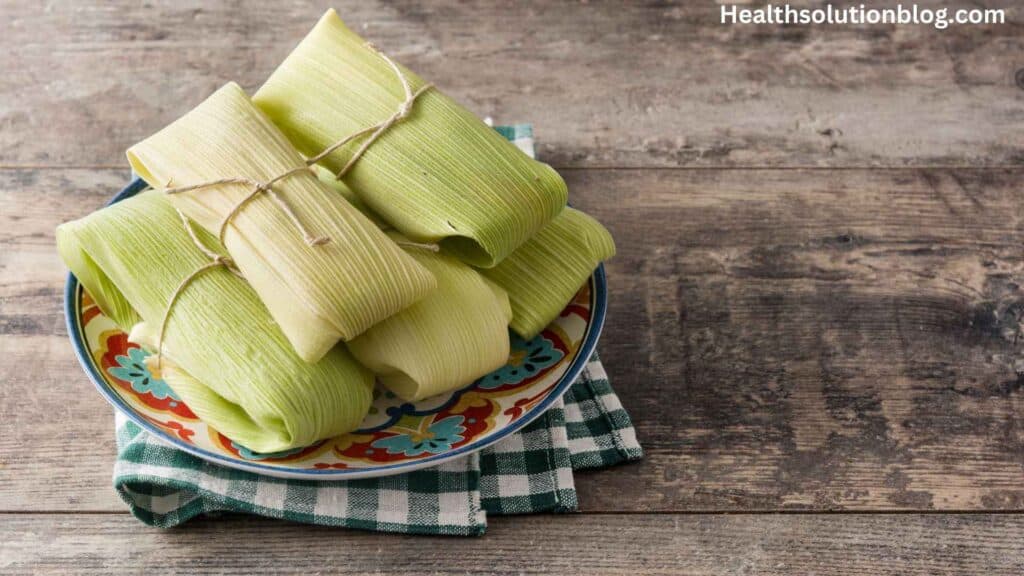
Ingredients:
- 2 cups whole-wheat dough
- 1 teaspoon salt
- 1 teaspoon baking powder
- 1/4 cup olive oil
- 1 1/2 cups warm chicken broth
- 1 pound boneless, skinless chicken breasts, cooked and shredded
- 1/2 cup chopped onion
- 1/4 cup chopped bell pepper
- 1/4 cup chopped cilantro
- 1/4 teaspoon chili powder
- 1/4 teaspoon cumin
- 1/4 teaspoon salt
- 1/4 teaspoon black pepper
- 12 corn husks
Instructions:
- In a large bowl, combine the dough, salt, and baking powder.
- Add the olive oil and chicken broth and mix until well combined.
- In a separate bowl, combine the chicken, onion, bell pepper, cilantro, chili powder, cumin, salt, and black pepper.
- To assemble the tamales, place a spoonful of dough in the center of a corn husk.
- Top with a spoonful of the chicken mixture.
- Fold the corn husk in half and fold the ends in to seal.
- Repeat steps 4-6 with4–6e remaining dough and chicken mixture.
- Place the tamales in a steamer basket and steam for 30 minutes, or until the dough is cooked through.
- Let the tamales cool slightly before serving.
This recipe makes about 12 tamales. Each tamale contains about 150 calories, 5 grams of fat, 25 grams of carbohydrates, and 10 grams of protein.
2. Vegetarian Tamales
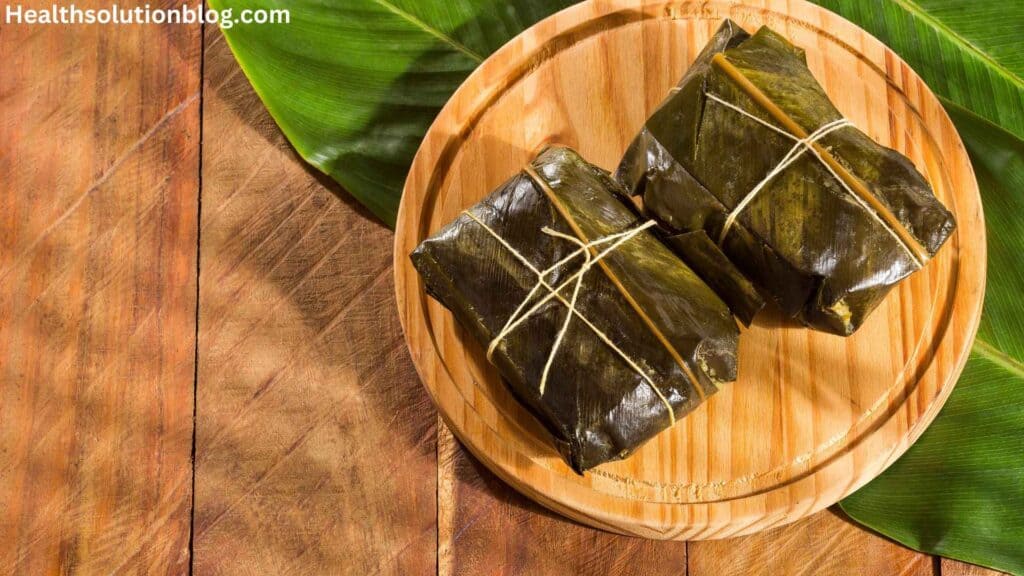
Ingredients:
- 2 cups whole-wheat dough
- 1 teaspoon salt
- 1 teaspoon baking powder
- 1/4 cup olive oil
- 1 1/2 cups warm vegetable broth
- 1 (15-ounce) can black beans, drained and rinsed
- 1/2 cup corn kernels
- 1/4 cup chopped onion
- 1/4 cup chopped bell pepper
- 1/4 cup chopped cilantro
- 1/4 teaspoon chili powder
- 1/4 teaspoon cumin
- 1/4 teaspoon salt
- 1/4 teaspoon black pepper
- 12 corn husks
Instructions:
- In a large bowl, combine the dough flour, salt, and baking powder.
- Add the olive oil and vegetable broth and mix until well combined.
- In a separate bowl, combine the black beans, corn, onion, bell pepper, cilantro, chili powder, cumin, salt, and black pepper.
- To assemble the tamales, place a spoonful of dough in the center of a corn husk.
- Top with a spoonful of the black bean mixture.
- Fold the corn husk in half and fold the ends in to seal.
- Repeat steps 4-6 with the remaining dough and black bean mixture.
- Place the tamales in a steamer basket and steam for 30 minutes, or until the dough is cooked through.
- Let the tamales cool slightly before serving.
This recipe makes about 12 tamales. Each tamale contains about 125 calories, 4 grams of fat, 20 grams of carbohydrates, and 7 grams of protein.
3. Chicken and Vegetable Tamales
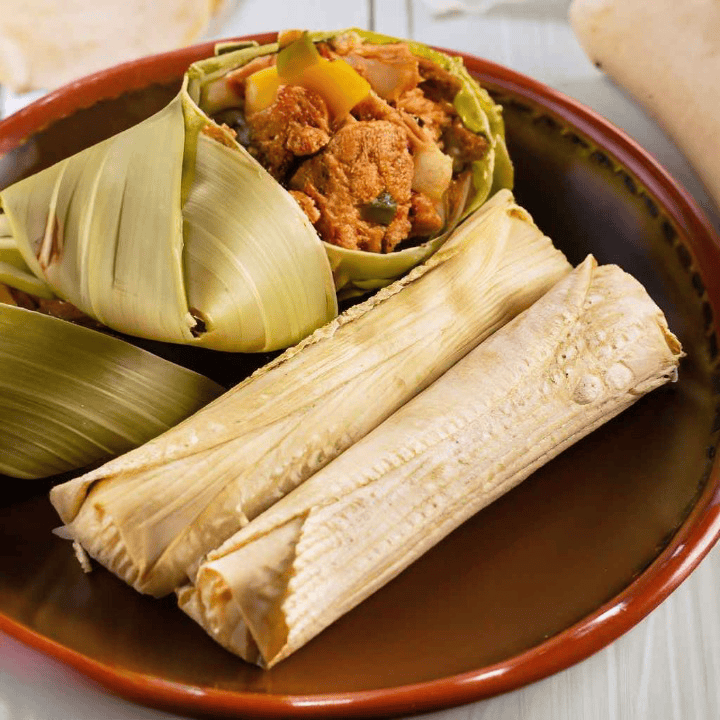
Ingredients:
- 2 cups whole-wheat dough
- 1 teaspoon salt
- 1 teaspoon baking powder
- 1/4 cup olive oil
- 1 1/2 cups warm chicken broth
- 1 pound boneless, skinless chicken breasts, cooked and shredded
- 1/2 cup chopped onion
- 1/4 cup chopped bell pepper
- 1/4 cup chopped cilantro
- 1/4 teaspoon chili powder
- 1/4 teaspoon cumin
- 1/4 teaspoon salt
- 1/4 teaspoon black pepper
- 12 corn husks
Instructions:
- In a large bowl, combine the dough flour, salt, and baking powder.
- Add the olive oil and chicken broth and mix until well combined.
- In a separate bowl, combine the chicken, onion, bell pepper, cilantro, chili powder, cumin, salt, and black pepper.
- To assemble the tamales, place a spoonful of dough in the center of a corn husk.
- Top with a spoonful of the chicken and vegetable mixture.
- Fold the corn husk in half and fold the ends in to seal.
- Repeat steps 4-6 with the remaining dough and chicken and vegetable mixture.
- Place the tamales in a steamer basket and steam for 30 minutes, or until the dough is cooked through.
- Let the tamales cool slightly before serving.
This recipe makes about 12 tamales. Each tamale contains about 150 calories, 5 grams of fat, 25 grams of carbohydrates, and 10 grams of protein.
These are just a few examples of diabetic-friendly tamale recipes. There are many other recipes available online and in cookbooks. It is important to find recipes that fit your individual dietary needs and taste preferences.
Conclusion
Tamales are a traditional Mexican dish made of corn dough (dough) and a variety of fillings, such as meat, cheese, vegetables, and fruits. They are a popular food for special occasions, but they can also be enjoyed as an everyday meal.
Are tamales suitable for diabetics?
Tamales are not an ideal food choice for diabetics, but people with diabetes can still enjoy them in moderation. It is important to choose tamales that are made with healthy ingredients and to limit your intake of tamales that are high in saturated fat, cholesterol, and sodium.
In the above article, three diabetic-friendly tamale recipes are explained. They are:
- Healthier Tamales for Diabetics
- Vegetarian Tamales
- Chicken and Vegetable Tamales
These recipes are all made with healthy ingredients, such as whole-wheat dough, lean protein, and vegetables. They are also steamed or baked, which reduces the amount of fat in the tamales.
I encourage you to try one of these recipes if you are looking for a diabetic-friendly way to enjoy tamales.
FAQ– Can diabetics eat tamales?
Q: What are tamales?
A: Tamales are a traditional Mexican dish made of corn dough (dough) and a variety of fillings, such as meat, cheese, vegetables, and fruits. They are typically wrapped in corn husks and steamed.
Q: Are tamales suitable for diabetics?
A: Tamales are not an ideal food choice for diabetics, but people with diabetes can still enjoy them in moderation. It is important to choose tamales that are made with healthy ingredients and to limit your intake of tamales that are high in saturated fat, cholesterol, and sodium.
Q: What are some tips for diabetics who want to enjoy tamales?
A: Here are some tips for diabetics who want to enjoy tamales:
- Choose tamales that are made with whole-wheat dough instead of white dough.
- Fill your tamales with lean protein, such as chicken or fish.
- Add vegetables to your tamales, such as spinach, onions, and peppers.
- Limit the amount of cheese and other high-fat ingredients in your tamales.
- Steam or bake your tamales instead of frying them.
- Eat your tamales in moderation.
- Pair your tamales with a healthy side dish, such as a salad or grilled vegetables.
- Avoid eating tamales with sugary drinks, such as soda or juice.
- Monitor your blood sugar levels before and after eating tamales.
Q: What are some diabetic-friendly tamale recipes?
A: Here are some diabetic-friendly tamale recipes:
- Healthier Tamales for Diabetics
- Vegetarian Tamales
- Chicken and Vegetable Tamales
Q: How often should diabetics eat tamales?
A: Diabetics should talk to their doctor about how often they should eat tamales. However, it is generally recommended that diabetics limit their intake of carbohydrates to 45-60 grams per meal. One medium-sized tamale contains about 30-40 grams of carbohydrates.
Q: What are the nutritional facts of tamales?
A: A medium-sized tamale contains about 250-300 calories, 10-15 grams of fat, 5-10 grams of protein, and 30-40 grams of carbohydrates.
Q: What are the different types of tamales?
A: There are many different types of tamales, but some of the most popular include:
- Oaxaqueños tamales: These tamales are made with a special type of corn dough called nixtamal. They are typically filled with meat, cheese, and mole.
- Chiapanecos tamales: These tamales are made with a variety of fillings, such as chicken, pork, beef, fish, and vegetables. They are typically wrapped in banana leaves.
- Yucatecos tamales: These tamales are made with a variety of fillings, such as cochinita pibil (slow-roasted pork), chicken, and seafood. They are typically wrapped in corn husks or banana leaves.
Q: How to make tamales at home?
A: To make tamales at home, you will need:
- Corn dough
- Corn husks
- Filling of your choice
- Water
- Salt
Instructions:
- Soak the corn husks in warm water for at least 30 minutes.
- In a large bowl, combine the corn dough, salt, and water. Mix until well combined.
- Place a spoonful of the corn dough on a corn husk.
- Top with your desired filling.
- Fold the corn husk in half and roll it up.
- Use a corn husk to tie the tamale closed.
- Repeat steps 3-6 with the remaining corn dough and filling.
- Place the tamales in a steamer basket and steam for 30-45 minutes, or until cooked through.
- Let the tamales cool slightly before serving.
Q: Where can I buy tamales?
A: Tamales can be purchased at many Mexican restaurants and grocery stores. You can also find them at some farmers’ markets and specialty food stores.
Q: How to store tamales?
A: Tamales can be stored in the refrigerator for up to 4 days or in the freezer for up to 3 months. To reheat tamales, steam them for 15-20 minutes, or until heated through.





